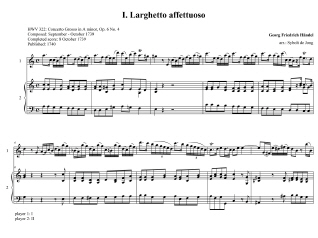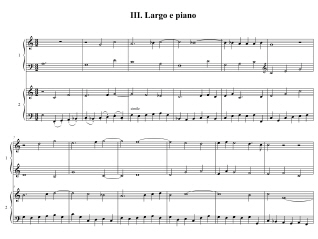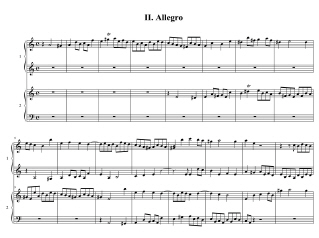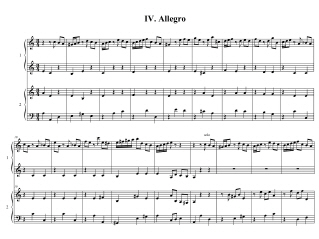Concerto Grosso in a minor
Op. 6 No. 4 - HWV 322, 1739
Composed 8 October 1739/ Published: 1740
The concluding Allegro takes its thematic material from an aria in the opera, Imeneo (HWV 41)
Movements: Larghetto affettuoso, Allegro, Largo e piano, Allegro
Transcribed for organ duet by Sybolt de Jong
II/P (C - d3)
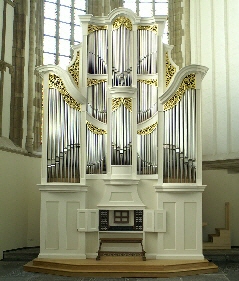
|
Fragment movement IV Allegro Euwe & Sybolt de Jong Bach-organ - Grote Kerk Dordrecht, The Netherlands |
| Verschueren Orgelbouw | Live recording 2009 - Aad vd Waal |
| player 1: medium | player 2: medium |
The fourth concerto in A minor is a conventional orchestral concerto in four movements, with very little writing for solo strings, except for brief passages in the second and last movements.
The first movement, marked larghetto affetuoso, has been described as one of Handel's finest movements, broad and solemn. The melody is played by the first violins in unison, their falling appoggiatura semiquavers reflecting the galant style. Beneath them, the bass part moves steadily in quavers, with extra harmony provided by the inner parts.
The second allegro is an energetic fugue, the brief exchanges between concertino and ripieno strictly derived from the unusually long subject. The sombreness of the movement is underlined by the final cadence on the lowest strings of the violins and violas.
The largo e piano in F major is one of Handel's most sublime and simple slow movements, a sarabande in the Italian trio sonata style. Above a steady crotchet walking bass, the sustained theme is gently exchanged between the two violin parts, with imitations and suspensions; harmonic colour is added in the discreet viola part. In the closing bars the crotchet figure of the bass passes into the upper strings before the final cadence.
The last movement, an allegro in A minor, is a radical reworking of a soprano aria that Handel was preparing for his penultimate opera Imeneo. In the concerto, the material is more tightly argued, deriving from two fragmented highly rhythmic figures of 5 and 6 notes. Although there are unmistakable elements of wit in the imaginative development, the prevalent mood is serious: the sustained melodic interludes in the upper strings are tinged by unexpected flattened notes. In the coda, the first concertino violin restates the main theme, joined two bars later in thirds by the other solo violin and finally by repeated sustained pianissimo chords in the ripieno, modulating through unexpected keys. This is answered twice by two forte unison cadences, the second bringing the movement to a close.
[Source Wikipedia]
| € 15,= | The arrangement (PDF) and invoice will be sent by mail. |

